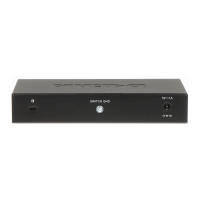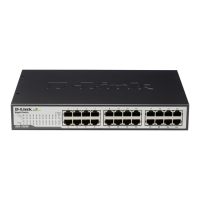DGS-1510 Series Gigabit Ethernet SmartPro Switch CLI Reference Guide
493
Level: 12.
Usage Guideline
Use the mls qos aggregate-policer command in the global configuration mode to create a named
aggregate policer. Then use the police aggregate command in the policy-map class configuration
mode to configure the named aggregate policer as the policy for a traffic class. A named aggregate
policer cannot be referenced from a different policy map. If a named aggregate policer is attached to
multiple ingress ports, the metering operation of the policer will not be applied to the aggregate traffic
but remains applied to the traffic received on the individual port.
Example
This example shows how to configure a named aggregate policer’s parameters and apply the policer
to multiple classes in a policy map: An aggregate policer with single rate policing named
“agg_policer1” is created. This policer is configured as the policy for traffic class 1, 2, and 3.
Switch# configure terminal
Switch(config)# mls qos aggregate-policer agg_policer1 10000 16384 exceed-action
drop
Switch(config)# policy-map policy2
Switch(config-pmap)# class class1
Switch(config-pmap-c)# police aggregate agg_policer1
Switch(config-pmap-c)# exit
Switch(config-pmap)# class class2
Switch(config-pmap-c)# police aggregate agg_policer1
Switch(config-pmap-c)# exit
Switch(config-pmap)# class class3
Switch(config-pmap-c)# police aggregate agg_policer1
Switch(config-pmap-c)#
56-15 police cir
This command is used to configure traffic policing for two rates, the committed information rate (CIR)
and the peak information rate (PIR). Use the no form of this command to remove two-rate traffic
policing.
police cir CIR [bc COMMITTED-BURST] pir PIR [be PEAK-BURST] [conform-action ACTION]
[exceed-action ACTION [violate-action ACTION]] [color-aware]
no police
Parameters

